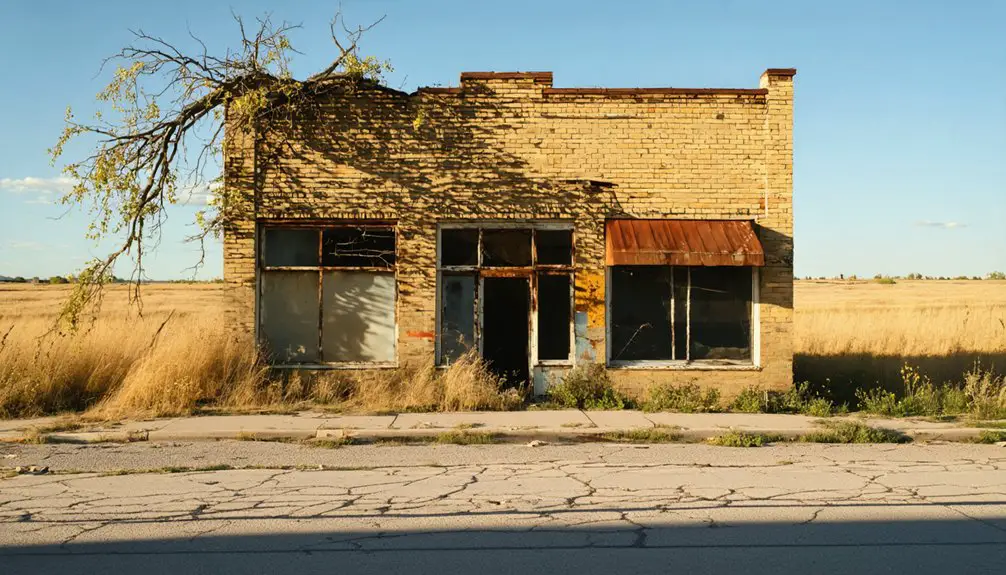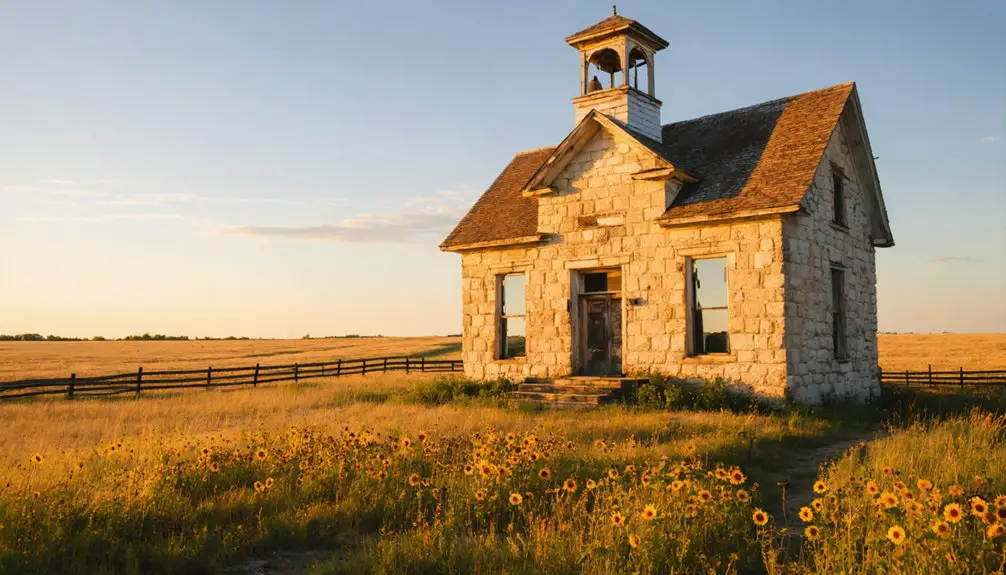You’ll find Long Island nestled between two creeks in Phillips County, Kansas, where it thrived as a bustling railroad town after 1885. The community faced early challenges like the 1874 grasshopper plague and Turkey Creek flooding, but persevered through agricultural innovation and strong social bonds centered around its churches and lodges. While the mid-20th century’s economic shifts and mechanization led to its ghost town status, Long Island’s rich frontier heritage holds countless untold stories.
Key Takeaways
- Long Island, Kansas, transformed from a thriving railroad town established in 1869 to a ghost town by the mid-twentieth century.
- Located between the Solomon River and nearby creek, the town was initially prosperous due to fertile farmland and railroad connections.
- Three churches, two lodges, and general stores formed the town’s social hub until population decline began in the 1950s.
- Economic factors, including loss of railroad service and agricultural mechanization, drove younger residents to urban areas.
- The town’s abandonment resulted from declining commerce, reduced agricultural labor needs, and urban migration of its population.
The Birth of a Frontier Settlement
Before becoming a frontier settlement, the area now known as Long Island, Kansas, was home to the Kanza and Osage tribes who established villages along the Kansas and Saline Rivers. The Kanza people were known as skilled hunters who faced displacement by Ioway and Sauk tribes armed with firearms from white traders. Native Americans named this land “Long Island” due to its unique position between two waterways, creating a peninsula-like formation between the Solomon River and a nearby creek. French fur trappers traded extensively with local tribes in the region during the early exploration period. You’ll find the first recorded settler experiences began with Amos Cole in 1869, who chose this fertile valley near the Solomon River in Phillips County.
Early Challenges and Natural Disasters
While Long Island’s first year of crop production in 1873 showed promise, you’ll find that everything changed when devastating swarms of grasshoppers destroyed the entire harvest in 1874, forcing many settler families to abandon their homesteads and return east.
The community’s location near water bodies made it vulnerable to creek flooding, which posed an ongoing threat to early farmers trying to establish themselves. Similar to the former town of Cow Skin, the harsh frontier conditions tested the will of early pioneers. The Dust Bowl and other economic downturns of the era devastated many farming communities across the Great Plains.
You can trace the settlement’s initial struggles directly to these natural disasters, which tested the resolve of frontier families and shaped the town’s early development patterns.
Devastating 1874 Grasshopper Plague
During the summer of 1874, Long Island’s fledgling community faced a devastating grasshopper plague that devoured entire fields of crops and vegetables, forcing many families to abandon their homesteads temporarily.
The grasshopper infestation struck just five years after the town’s founding, destroying the promising harvests that settlers had cultivated since 1873.
Like many of Kansas’s over 6000 dead towns, Long Island struggled to maintain its population in the face of such severe agricultural challenges.
You’ll find that this natural disaster created severe economic hardship throughout the region, compelling many residents to return east.
The plague’s impact reached far beyond immediate crop losses – it disrupted the community’s social fabric, delayed the town’s development, and challenged the survival of recently established schools and churches.
Long Island’s experience reflected a broader regional catastrophe that tested settlers’ resilience across the Great Plains.
Similar to the situation in Bell Plane, agriculture remained the primary means of survival for those who stayed, though many struggled to rebuild after the devastation.
Creek Flooding Impact
Throughout Long Island’s early years, Turkey Creek posed a persistent threat to the community’s stability, with severe flooding events wreaking havoc on local infrastructure and livelihoods. The devastating 1993 Flood threatened to overtop levees and displaced hundreds of graves from a local cemetery.
Despite early flood mitigation efforts, including the ambitious 1918 tunnel project to redirect waters to the Kansas River, the creek continued to overflow during intense rainfall. During peak flows, the creek reached approximately 19,000 cubic feet per second, far exceeding the tunnel’s 8,000 cubic feet capacity.
When three and a half inches of rain fell rapidly, the resulting floods would submerge power transformers and overwhelm pump stations, severely testing the town’s economic resilience.
As part of a broader pattern of flooding across northeast Kansas, these events contributed to the region’s vulnerability, with damages sometimes reaching millions in modern terms.
The community faced constant challenges in maintaining its infrastructure and protecting its businesses from flood-related closures and costly cleanups.
Early Crop Production Struggles
Despite initial agricultural promise in 1873 with a “beautiful crop” harvest, Long Island’s early settlers soon faced devastating natural disasters that tested their resilience.
The town’s agricultural dreams were shattered in 1874 when swarms of grasshoppers destroyed all vegetable crops, forcing many families to abandon their homesteads and return east.
Amos Cole and his fellow settlers established the first community in 1869, laying the groundwork for future agricultural development.
Without modern agricultural innovations to protect their harvests, farmers struggled against recurring insect plagues, unpredictable weather, and flooding from nearby creeks. The struggles mirrored those faced by Route 66 towns like Jericho Gap where difficult conditions routinely challenged local survival.
Crop resilience was continuously challenged by droughts, early frosts, and seasonal water fluctuations that complicated farming cycles.
It wasn’t until the railroad’s arrival in 1885 that you’d see a turning point, as improved transportation finally provided stable market access and new farming technologies that helped rebuild the community’s agricultural foundation.
Railroad Era and Economic Growth
You’d find Long Island’s transformation began in 1885 when the railroad arrived, connecting the town to larger markets and bringing new economic opportunities.
The business district quickly expanded as merchants and services established themselves near the rail line, taking advantage of improved transportation access.
Your community would have witnessed the railroad’s impact through new grain storage facilities, retail establishments, and increased trade activity that marked Long Island’s peak development period.
Railroad Brings New Life
The arrival of railroads in Kansas during the mid-19th century transformed Long Island’s economic landscape and connectivity to the wider region. You’d have witnessed dramatic changes as railroad expansion brought new opportunities, connecting your community to major markets in Missouri and Texas.
The railroad’s presence sparked an immigrant influx, bringing fresh faces and diverse skills to your area. You could’ve seen how the Missouri-Kansas-Texas Railroad, known as the “Katy,” linked your region to broader commercial networks, creating jobs in construction and related industries.
Local farmers and ranchers gained access to distant markets, making their operations more profitable. The railways didn’t just lay tracks – they laid the foundation for your community’s growth, reducing transport costs and time while boosting the competitiveness of local products.
Business District Expansion 1885
While railroad connections brought initial prosperity to Long Island, 1885 marked a remarkable expansion of its business district with diverse enterprises serving the growing community.
You’d find essential services like a general store, bank, and drugstore alongside specialized establishments including blacksmith shops, barber shops, and wagon repair facilities. The business diversity extended to social venues such as dance halls and gambling establishments.
The town’s economic dynamism attracted real estate agencies and loan offices, though economic volatility meant many businesses opened and closed rapidly.
You could count on finding the post office centrally located, serving as a crucial communication hub since 1880. Local business leaders actively pursued growth opportunities through infrastructure investment, while production industries like cheese plants demonstrated the community’s entrepreneurial spirit.
Life Between Two Creeks

Situated between two life-sustaining creeks, Long Island’s early settlers strategically established their community to capitalize on the natural advantages of the location.
You’d have found these pioneering families selecting prime spots for their homes and farms, carefully positioning them away from flood-prone areas while maintaining easy access to water resources.
Living between the creeks offered you both opportunities and challenges. While the fertile soil supported robust farming operations, you’d need to adapt to the settlement patterns dictated by the terrain.
The delicate balance of creek life shaped farming success, as settlers learned to work within nature’s boundaries rather than against them.
Your daily life would’ve centered around the creeks, which provided essential water for household use and agricultural needs. The waterways also served as natural transportation routes, connecting you to neighboring communities and markets, though you’d have to remain vigilant about potential flooding during heavy rains.
Agricultural Legacy and Rural Traditions
From its earliest days, Long Island’s agricultural heritage flourished through a diverse mix of crops and livestock that defined the community’s character.
You’ll find that agricultural innovations transformed this Kansas settlement from basic subsistence farming into a thriving commercial enterprise by the 19th century.
The rural traditions that shaped Long Island’s farming community included:
- Mixed husbandry combining wheat, corn, oats, rye, and other grains
- Integration of livestock operations with crop production
- Mechanization through tractor adoption starting in 1925
- Railroad transportation enabling broader market access
- Research-driven improvements in seed varieties and farming techniques
The community’s adaptability showed in how farmers responded to challenges, diversifying their operations and embracing new technologies while maintaining strong agricultural roots between the area’s two creeks.
Community Spirit and Social Life

Beyond the fertile fields and farming innovations, Long Island’s vibrant community spirit manifested through its rich social institutions and gathering places.
You’d find three churches and two lodges serving as the backbone of social cohesion, while two general stores, including J.C. Moore’s Grocery, acted as daily meeting spots for residents.
The town’s dance halls and gambling establishments added excitement to local nightlife, creating spaces where you could unwind and connect with neighbors.
When disasters struck, like the floods of 1903 and fires of 1905 and 1907, you’d witness the community banding together, demonstrating remarkable resilience through collective recovery efforts.
Monthly lodge meetings, church functions, and social events at local establishments strengthened bonds between townspeople until the mid-1950s, when external forces prompted relocation.
Decline and Transformation
As the mid-twentieth century approached, Long Island’s once-thriving community began experiencing severe decline through multiple economic and social pressures.
You’ll find that population shifts and economic decline transformed this Kansas town dramatically, driven by:
- Loss of critical railroad connections that once sustained local commerce
- Mechanization of farming that reduced agricultural labor needs
- Exodus of younger residents to larger urban centers
- Closure of essential businesses and community institutions
- Competition from nearby cities that drew away commerce
The town’s transformation reflected broader regional changes as technological advances and economic forces reshaped rural America.
Rural communities nationwide faced upheaval as modern technology and market forces transformed the agricultural heartland’s economic landscape.
What you’d have seen was a steady decrease in occupied homes, while remaining residents consolidated around the few surviving amenities.
Local industries couldn’t adapt quickly enough to maintain the town’s economic base, leading to its eventual classification as a ghost town.
Historical Landmarks and Preservation

While many Kansas ghost towns have faded into obscurity, Long Island’s historical landmarks tell a compelling story through their preserved architecture and cultural significance.
You’ll find a mix of limestone and wooden structures that showcase the region’s building practices from the late 1800s to early 1900s. The town’s historical preservation efforts have focused on maintaining key buildings like post offices, schools, and churches that represent the community’s past importance.
Through public and private partnerships, local historical societies work to protect these architectural treasures. You can explore false-front commercial buildings and unique features like concrete block structures that reveal the town’s economic and social development.
Many sites have earned spots on state and national historic registers, ensuring their protection and celebrating their architectural significance in Kansas’s settlement history.
Modern-Day Stories and Heritage Tourism
Today’s Long Island ghost town attracts visitors through a fascinating mix of heritage tourism and local folklore.
You’ll discover how ghost stories and urban legends have shaped the town’s identity, drawing curious explorers and history enthusiasts alike.
- Local heritage tours showcase preserved landmarks while sharing authentic cultural narratives.
- Community engagement efforts blend historical preservation with modern tourism needs.
- Ghost stories and supernatural tales keep the town’s memory alive for new generations.
- Tourism impact provides modest economic benefits through seasonal visitors.
- Preservation efforts balance site access with protecting fragile structures.
You’ll find the town’s mystique enhanced by tales of mysterious lights and unexplained phenomena, while heritage tourism helps sustain local businesses and guides.
The blend of fact and folklore creates a unique experience that connects you to Long Island’s frontier past through both its physical remnants and enduring stories.
Frequently Asked Questions
What Happened to the Original Buildings and Structures in Long Island?
You’ll find most abandoned structures have collapsed or deteriorated due to weather, neglect, and time. Trees now grow through ruins, with minimal historical preservation efforts maintaining any original buildings.
Were There Any Notable Crimes or Lawlessness During Long Island’s Peak?
Unlike the Wild West tales you’ve heard, there weren’t any notable crime statistics or significant lawlessness recorded. The agricultural community maintained order without requiring substantial law enforcement presence.
Did Native American Tribes Have Settlements Near Long Island Before Colonization?
You’ll find the Kansa, Osage, and Pawnee tribes had settlements in the region. They’d established multiple Native American tribal settlements along nearby rivers and creeks before European colonization pushed them westward.
What Was the Highest Recorded Population in Long Island’s History?
You’ll find that 513 residents marked the peak population in 1880, a significant milestone in population trends that highlights the historical significance of this community’s once-thriving settlement era.
Are There Any Remaining Businesses or Services Operating Today?
Like many ghost town businesses that fade into history, you won’t find any surviving services operating in Long Island today. The once-vibrant community has completely ceased commercial operations in modern times.
References
- https://www.geotab.com/ghost-towns/
- https://legendsofkansas.com/kansas-ghost-town-list/
- https://www.youtube.com/watch?v=OyBXD18P_j4
- https://www.phillipscountyks.org/history-of-long-island
- https://www.longislandhistoryproject.org/long-island-kansas-with-carrie-cox/
- https://legendsofkansas.com/native-american-history-kansas/
- https://en.wikipedia.org/wiki/History_of_Kansas
- https://www.inmotionaame.org/print.cfm@migration=6.html
- https://fhsuguides.fhsu.edu/kansasheritage/phillipscounty
- https://www.youtube.com/watch?v=VPZtNoncnig



